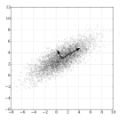Machine learning (ML) methods have proved to be a very successful tool in physical sciences, especially when applied to experimental data analysis. Artificial intelligence is particularly good at recognizing patterns in high dimensional data, where it usually outperforms humans. Here we applied a simple ML tool called principal component analysis (PCA) to study data from muon spectroscopy. The measured quantity from this experiment is an asymmetry function, which holds the information about the average intrinsic magnetic field of the sample. A change in the asymmetry function might indicate a phase transition; however, these changes can be very subtle, and existing methods of analyzing the data require knowledge about the specific physics of the material. PCA is an unsupervised ML tool, which means that no assumption about the input data is required, yet we found that it still can be successfully applied to asymmetry curves, and the indications of phase transitions can be recovered. The method was applied to a range of magnetic materials with different underlying physics. We discovered that performing PCA on all those materials simultaneously can have a positive effect on the clarity of phase transition indicators and can also improve the detection of the most important variations of asymmetry functions. For this joint PCA we introduce a simple way to track the contributions from different materials for a more meaningful analysis.
翻译:实践证明,机器学习(ML)方法在物理科学中是一个非常成功的工具,特别是在应用到实验数据分析时。人工智能在识别高维数据模式方面特别擅长,因为高维数据模式通常优于人类。在这里,我们应用了一个简单的 ML 工具,称为主元件分析(PCA), 以研究来自粘膜光谱仪的数据。 实验中测量的数量是一个不对称功能, 包含关于样本中平均内在磁场的信息。 不对称功能的变化可能表明一个阶段过渡; 但是, 这些变化可能非常微妙, 现有的数据分析方法需要了解材料的具体物理特征。 CPA是一个不受监督的 ML 工具, 这意味着不需要对输入数据进行假设, 但我们发现仍然可以成功地应用于偏差曲线, 并且可以恢复阶段过渡的迹象。 这种方法被应用于一系列具有不同基础物理学的磁材料。 我们发现, 对所有这些材料同时使用五氯苯甲醚,可以对阶段过渡指标的清晰度产生积极的影响, 并且也可以改进对不对称功能的最重要变化的检测。



